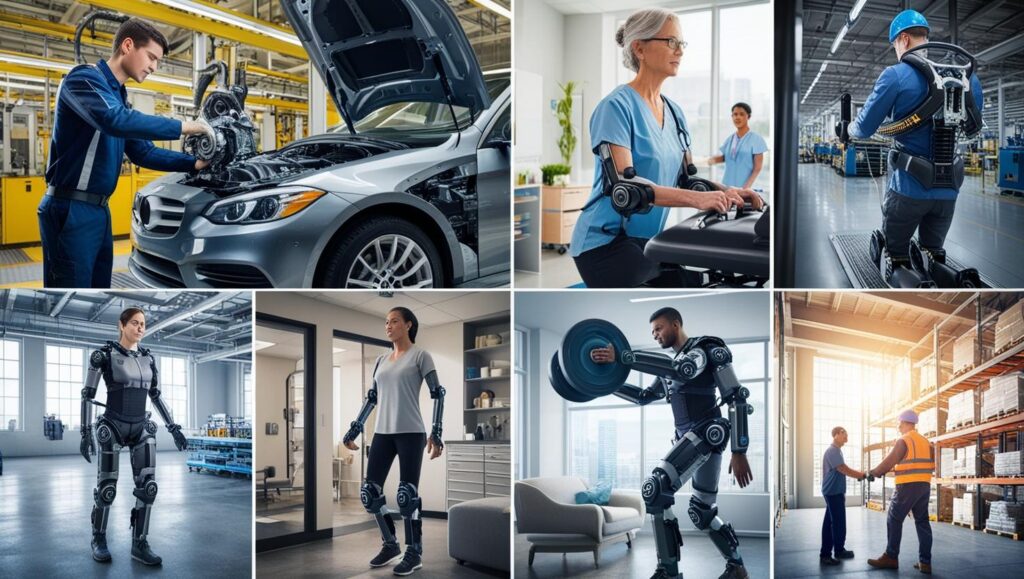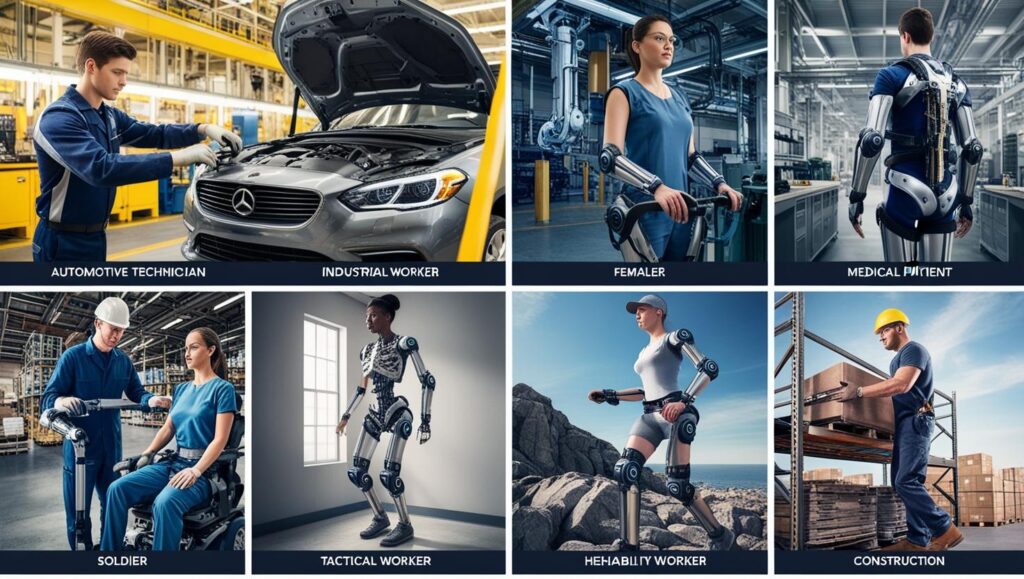The impact of AI on the exoskeleton market is reshaping the future of human mobility and wearable robotics. Artificial Intelligence is transforming exoskeletons from rigid support systems into intelligent, responsive platforms capable of adapting to individual users and environments. By integrating real-time data processing, machine learning, and predictive control, AI enables exoskeletons to enhance rehabilitation outcomes, improve workplace safety, and optimize physical performance in military and industrial applications.
As AI technologies continue to advance, the exoskeleton market is set for rapid growth—unlocking new opportunities across healthcare, defense, logistics, and personal mobility. The path forward is clear: AI-powered exoskeletons will play a pivotal role in bridging human capability with robotic precision, ushering in a new era of adaptive, intelligent movement.

Shifting from Mechanical to Intelligent Mobility
Traditional exoskeletons relied heavily on pre-programmed motion and manual control. These early models, while groundbreaking, offered limited adaptability to real-world variability in user movement, fatigue, or environmental changes. The integration of AI changes that paradigm. Through the use of machine learning algorithms, real-time data processing, and sensor fusion, AI-powered exoskeletons can now analyze a user’s movement, anticipate intent, and adjust support dynamically.
This shift is creating smarter, safer, and more personalized devices that enhance mobility, reduce injury risk, and improve user comfort. Whether it’s a rehabilitation patient learning to walk again, a factory worker lifting heavy loads, or a soldier carrying gear across rough terrain, AI allows the exoskeleton to behave as an extension of the user’s body, rather than as an external machine.
AI by Component: Smarter Hardware, Smarter Decisions
AI’s impact extends deeply into the individual components of exoskeleton systems. Sensors such as accelerometers, gyroscopes, and electromyography (EMG) devices feed real-time motion and muscle activity data into AI models. Controllers then use predictive analytics to adjust the exoskeleton’s actuators for smooth and responsive movement. Meanwhile, software platforms are evolving to include cloud-based analytics, remote monitoring, and learning algorithms that adapt with user experience over time.
Power management is also being optimized with AI. Intelligent systems monitor energy use and redistribute power based on task demands, helping to extend battery life—especially critical for mobile or field-based applications.
Download PDF Brochure @ https://www.marketsandmarkets.com/pdfdownloadNew.asp?id=40697797
Functional Expansion: From Assistive to Augmentative Use
AI enables exoskeletons to serve a wider range of functional purposes. In assistive and rehabilitative applications, particularly in healthcare, AI allows for personalized therapy based on individual progress. Exoskeletons used in stroke or spinal injury rehabilitation can now adjust gait patterns, detect muscle fatigue, and guide patients through optimized movement sequences. This not only improves outcomes but also reduces recovery times.
In industrial and military settings, AI transforms exoskeletons into augmentative tools that boost strength, endurance, and precision. AI algorithms interpret environmental conditions—such as uneven ground or object weight—and adjust support accordingly. In factories, logistics, and construction sites, this capability helps prevent musculoskeletal injuries and improves productivity.

Global Exoskeleton Market Growth and Future Potential
The global exoskeleton market is projected to grow from USD 0.56 billion in 2025 to USD 2.03 billion by 2030, at a CAGR of 29.4% during the forecast period. Exoskeletons are wearable robotic systems designed to enhance human capabilities by supporting mobility, reducing fatigue, and aiding rehabilitation. The overall growth of the exoskeleton market is driven by advancements in artificial intelligence and machine learning, which are enabling smarter, more responsive systems that adapt to individual user needs. Key developments such as the FDA clearance of medical exoskeletons are boosting confidence among healthcare providers and expanding clinical adoption. The integration of AI is one of the primary accelerators of this trend, enabling a broader range of applications and improving user outcomes across sectors.
The convergence of AI with complementary technologies—such as 5G, IoT, and brain-computer interfaces (BCIs)—will only accelerate this growth. We can expect future exoskeletons to become lighter, more intuitive, and more deeply integrated into human cognition and motion.
Challenges Ahead
Despite its promise, the application of AI in exoskeletons also presents challenges. Ensuring data privacy, especially in healthcare and defense, is a critical concern. Additionally, power consumption and system complexity may limit long-term use or affordability. Interoperability with existing systems and regulatory compliance for safety and medical certification also remain barriers to widespread adoption.
AI is redefining what exoskeletons can achieve. No longer limited to rigid assistance, these intelligent systems are becoming adaptive partners in mobility, rehabilitation, and labor. By blending biomechanics with machine learning, the industry is moving toward a future where human performance is not just restored, but enhanced.
Key Opportunities in the AI-Powered Exoskeleton Market
Healthcare & Rehab: AI enables personalized therapy, real-time motion correction, and faster recovery for patients with mobility impairments.
Workplace Safety: In manufacturing, logistics, and construction, smart exoskeletons reduce fatigue and prevent injuries, improving productivity.
Defense & Military: AI-driven tactical suits enhance soldier endurance, situational awareness, and load-carrying capacity in extreme conditions.
IoT & Digital Twins: Integrating exoskeletons with IoT and analytics enables real-time monitoring, predictive maintenance, and workplace optimization.
Sports & Fitness: Athletes benefit from injury prevention, motion analysis, and performance-enhancing training tools powered by AI.
Consumer Mobility: Affordable, AI-adaptive exosuits for elderly users or those with chronic conditions are emerging for daily mobility support.
Remote & Emerging Markets: AI-enabled remote rehabilitation and mobility solutions offer scalable healthcare options in underserved regions.
AI is not just enhancing exoskeleton technology—it’s redefining it. By bringing intelligence, adaptability, and personalization to wearable robotics, AI is turning exoskeletons into powerful tools across healthcare, industry, defense, and beyond. As innovation accelerates, the market is set to shift from niche applications to mainstream adoption, empowering humans to move better, recover faster, and work safer. The future of mobility is not just mechanical—it’s intelligent.
About MarketsandMarkets™
MarketsandMarkets™ is a blue ocean alternative in growth consulting and program management, leveraging a man-machine offering to drive supernormal growth for progressive organizations in the B2B space. We have the widest lens on emerging technologies, making us proficient in co-creating supernormal growth for clients.
The B2B economy is witnessing the emergence of $25 trillion of new revenue streams that are substituting existing revenue streams in this decade alone. We work with clients on growth programs, helping them monetize this $25 trillion opportunity through our service lines – TAM Expansion, Go-to-Market (GTM) Strategy to Execution, Market Share Gain, Account Enablement, and Thought Leadership Marketing.
Built on the ’GIVE Growth’ principle, we work with several Forbes Global 2000 B2B companies – helping them stay relevant in a disruptive ecosystem. Our insights and strategies are molded by our industry experts, cutting-edge AI-powered Market Intelligence Cloud, and years of research. The KnowledgeStore™ (our Market Intelligence Cloud) integrates our research, facilitates an analysis of interconnections through a set of applications, helping clients look at the entire ecosystem and understand the revenue shifts happening in their industry.
To find out more, visit www.MarketsandMarkets™.com or follow us on Twitter, LinkedIn and Facebook.
Contact:
Mr. Aashish Mehra
MarketsandMarkets™ INC.
630 Dundee Road
Suite 430
Northbrook, IL 60062
USA : 1-888-600-6441